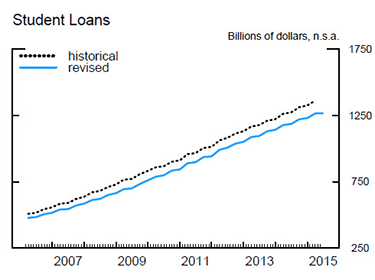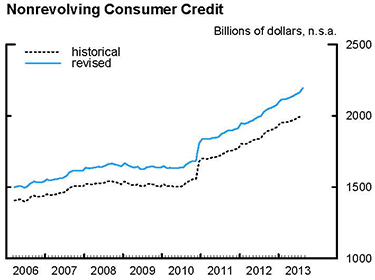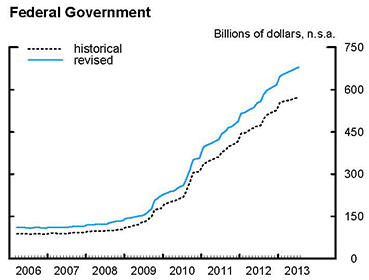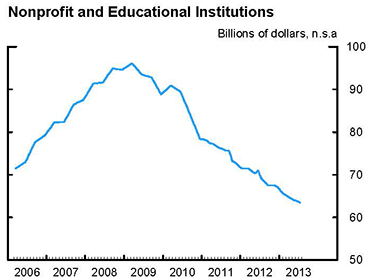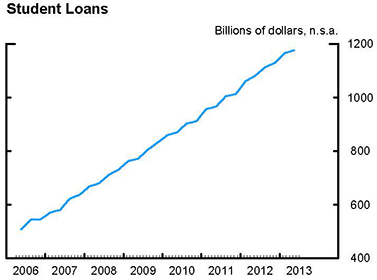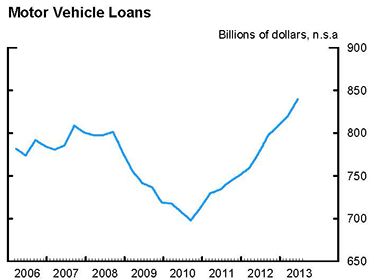Consumer Credit - G.19
Revisions RSS Data Download
August 7, 2015 revisions
Downward revisions to the student loan memo line item extending back to 2006 Q1 reflect the incorporation of improved private student loan data. The revisions range from about $32 billion to $95 billion. For more details, please see the Student Loan Memo line item description: www.federalreserve.gov/releases/g19/about/htm.
Additionally, upward revisions to total consumer loans owned by finance companies from January 2006 to December 2010 result from the correction of a technical error. The revisions range from about $100 million to $14 billion. All other series are unaffected.
May 7, 2015 revisions and additions
Revisions to the March G.19 extending back to January 2006 were primarily caused by updated seasonal factors and the benchmarking of estimates to data released by the Department of Education and the U.S. Census Bureau. The finance companies new car loan terms of credit series shown in prior releases were discontinued and replaced with new series that use different methodology. Please see the G.19 'About' page for more information.
October 7, 2013 revisions and additions
Revisions to the October G.19 extending back to January 2006 are attributable to changes in methodology to better reflect student loan debt outstanding.
Revisions to Nonrevolving Consumer Credit
Estimates of total nonrevolving consumer credit have been revised upward from January 2006 onward. The revisions are due to upward revisions to the Federal Government sector and the inclusion of a new sector, Nonprofit and Educational Institutions. The upward revisions to total nonrevolving credit range from about $90 billion to $170 billion.
Federal Government
The upward revisions to the Federal Government sector are attributed to the inclusion of Perkins loans, loans purchased under the Ensuring Continued Access to Student Loans Act of 2008 from nonprofit and educational institutions, all defaulted loans held by the federal government, and accrued interest on all federal student loan balances. The upward revisions extend back to January 2006 and range from about $20 billion to $110 billion.
Nonprofit and Educational Institutions
The new nonprofit and educational institutions estimates include only Federal Family Education Loan Program (FFELP) loans held by state-affiliated nonprofit lenders and schools--institutions previously not covered in the G.19. With the inclusion of the new sector, the G.19 accounts for essentially all major holders of student loans.
Student Loans Memo Item
The new student loans memo item reflects the total student loan debt outstanding including defaulted loans and accrued interest. The estimate is constructed by summing the total private and federal student loans outstanding, with federal loans consisting of those issued under the Direct Loan, Federal Family Education Loan, and Perkins programs. The estimate for federal student loans is benchmarked against data published by the Department of Education (http://studentaid.ed.gov/about/data-center/student/portfolio), while the estimate for private student loans is constructed by Federal Reserve staff using various data sources. The student loans memo item is not a strict subset of the total nonrevolving credit estimate because the memo item includes all defaulted loans, whereas the total nonrevolving credit estimate--calculated as the sum of loans held by the different sectors reported in the G.19 release--does not include all defaulted loans because depository institutions, credit unions, and finance companies do not report charge-off loans.
Motor Vehicle Loans Memo Item
The new motor vehicle loans memo item reflects the total motor vehicle loan debt outstanding. The estimate is constructed by summing motor vehicle loans held and managed by depository institutions, finance companies, credit unions, and nonfinancial business. The memo item is a strict subset of total nonrevolving credit.
April 5, 2013 revisions
Revisions to the February G.19 extending back to January 2006 were primarily caused by revised seasonal factors, the incorporation of the US Census' latest Annual Retail Trade Report, and revised finance companies source data.
September 10, 2012 revisions
Since 1955, the Federal Reserve has surveyed the finance company industry at five-year intervals to provide a comprehensive and accurate statistical snapshot of finance company lending to U.S. consumers and businesses. In recent years, a two-stage survey has been undertaken. First, the Census of Finance Companies (CFC) is conducted to identify the universe of such companies and to obtain information on the general characteristics of those firms. Second, the Survey of Finance Companies (SFC) is conducted to obtain more detailed data on the balance sheets and outstanding receivables of eligible firms identified in the CFC. The most recent CFC and SFC were conducted in 2010 and 2011, respectively. These surveys also serve as the benchmark for the monthly finance company data that the Federal Reserve collects from a smaller set of companies (FR2248). This data collection is an integral input into the Federal Reserve's Consumer Credit (G.19), Finance Companies (G.20), and Flow of Funds (Z.1) statistical releases.
Because administrative data and comprehensive private data are not available to serve as a sample frame for finance companies, the Federal Reserve developed a procedure for identifying the industry universe of eligible firms within a list sample frame obtained primarily from a third-party private company and, to a lesser degree, from other sources. The CFC questionnaire (FR3033p) was mailed to each company on the list. A large-scale nonresponse follow-up study was designed and undertaken to assess the nature of nonresponse in the CFC as well as the effects of nonresponse on the universe estimate. With the information collected from the CFC and the nonresponse follow-up study, an estimate of the universe of U.S. finance companies with respect to company size and loan specialization was constructed. The subsequent SFC (FR3033s) was sent to all of the identified finance companies in the CFC, collecting detailed information on company balance sheets and receivable portfolios as of December 31, 2010. Analysis weights were constructed for companies in the SFC (after taking into account survey nonrespondents), and the finance company industry universe statistics of balance sheet and receivable portfolios (referred to as the benchmark estimates) were estimated and employed to benchmark the monthly and quarterly finance companies statistics.
Because of the benchmarking process, the G.19 data have been revised from December 2010 forward. Due to changes in the representativeness of the monthly sample since the earlier benchmark in 2005, there are considerable discrepancies in some categories between the pre-benchmarked and the benchmarked estimates. Such discrepancies are reflected in the statistical releases as series breaks in December 2010 (the benchmarking month). 1 Therefore, the level differences between November and December 2010 due to benchmarking discrepancies do not affect the published growth rates of the corresponding series over this period. Also, analysis weights of the monthly longitudinal sample were re-estimated using the benchmarked industry universe statistics, and the monthly estimates after December 2010 were revised accordingly using the new weights.
June 7, 2012 revisions
Total Consumer Credit
Estimates of total consumer credit have been revised downward between January 2006 and March 2012, beginning with a series break of approximately negative $28 billion in January 2006. In all periods through March 2012, revisions are downward and relatively small, averaging slightly less than 1 1/4 percent of their former values. These changes are driven by larger downward revisions to nonrevolving credit, offset partially by upward revisions to revolving credit. Over the revision period, the new estimates are on average about $27 billion below the old estimates. Toward the end of the revision period, from March 2011 through March 2012, the gap is tighter, caused by a slight contraction in the downward revisions of nonrevolving credit and a slight expansion in the upward revisions of revolving credit. The average revision over this period is approximately negative $18 billion.
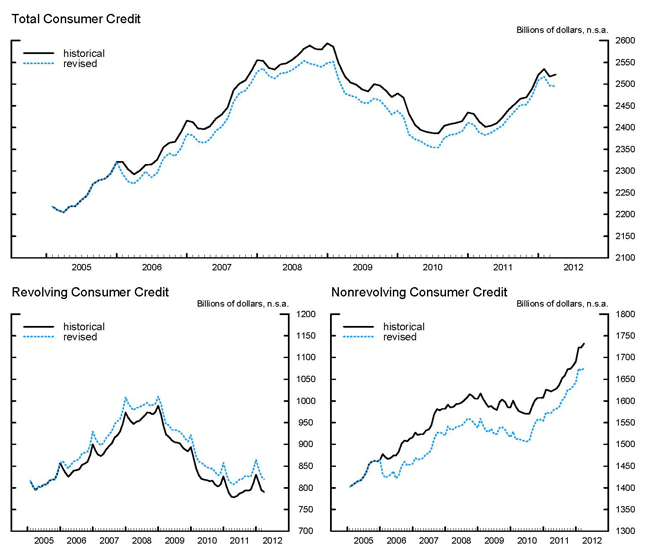
Nonrevolving Consumer Credit
Revisions to nonrevolving consumer credit are caused almost entirely by downward revisions to the nonfinancial business and securitized pools sectors. The average revision from January 2006 through March 2012 is slightly greater than 3 1/2 percent of its former value, with the new estimates staying relatively close to their average value of $55 billion below the old estimates. In the last two years of this period, the revisions contract moderately. From March 2010 through March 2012, revisions average about negative $53 billion, owing to upward revisions to the finance company sector.
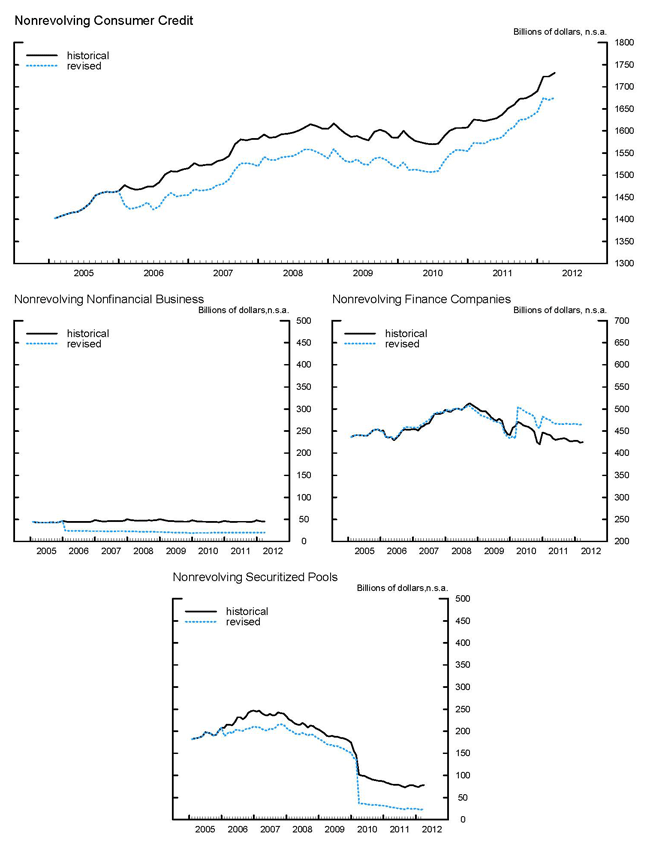
Revolving Consumer Credit
Upward revisions to revolving consumer credit are due mainly to nonfinancial business. Prior to March 2010, securitized pools contribute positively to the revisions, while corresponding declines in finance company estimates somewhat damp their effect. After March 2010, finance companies contribute positively, while offsetting declines of securitized pools estimates somewhat damp their effect. The average revision from January 2006 through March 2012 is slightly less than 3 1/4 percent of its former value, with most revisions about $27 billion above the old estimates. In March 2010, the gap widens somewhat because of adjustments for the accounting rule changes, Statements of Financial Accounting Standards (FAS) Nos. 166 and 167, which cause finance company estimates to jump by more than the offsetting decline of securitized pools.

Nonrevolving Consumer Credit Sectors
Nonfinancial Business
Revisions to nonrevolving credit from nonfinancial businesses are large and negative, beginning with a 46 percent decline in January 2006. The average revision through March 2012 is 53 percent (negative $24 billion) and accounts for approximately half of the revision in overall nonrevolving credit. Revisions to nonfinancial business nonrevolving estimates are caused entirely by a change in source data. Previously, estimates of nonrevolving nonfinancial business credit were generated from retail sales data from the U.S. Census Bureau's Monthly Retail Trade Report. New estimates, from January 2006 on, have been benchmarked to accounts receivable data from the U.S. Census Bureau's Annual Retail Trade Report. These data are currently the most direct measure of consumer credit extended by nonfinancial businesses. Monthly movements are estimated using the typical seasonal pattern for nonrevolving credit.
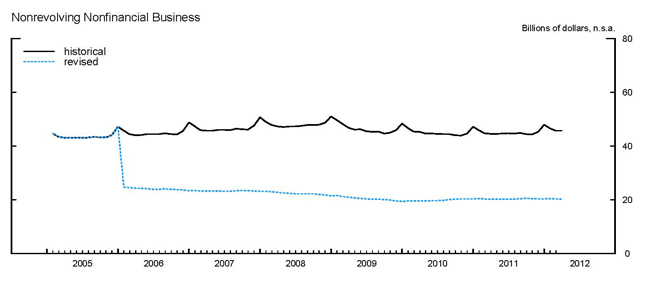
Finance Companies
From 2006 through 2009, revisions of nonrevolving credit held by finance companies are relatively small. The average revision over this period is approximately 1/4 percent (negative $1 billion) and has essentially no effect on the overall downward revisions to nonrevolving credit. Alterations to this series are due to minor idiosyncratic methodology changes and the incorporation of revisions to source data. Methodological changes include improved adjustments for panel attrition, panel growth, and loan sales and purchases by panel members.
In the first quarter of 2010, the revisions increase in magnitude and can be attributed to the timing of the implementation of the accounting changes FAS 166 and 167 2. In previous estimates, we allowed early (before the first quarter of 2010) consolidations to appear in the data as they occurred. In the new G.19 estimates, we have suppressed all increases in on-balance-sheet data due to FAS 166 and 167 until March 2010. This change causes downward revisions of about 4 and 6 percent ($19 and $28 billion) in January and February respectively. In March 2010, prior consolidations are no longer suppressed, and a large amount of newly consolidated consumer motor vehicle loans contribute the entire amount of the revision of approximately 7 1/4 percent ($34 billion). Because the increase is due to consolidation, it is wholly offset by finance companies' corresponding contribution to the decline in credit in securitized pools and thus does not affect total nonrevolving credit.
From March 2010 through March 2012, the new estimates are about $35 billion higher than the old estimates. During this period, the new estimates also reflect minor idiosyncratic changes in methodology and the incorporation of revisions to source data.
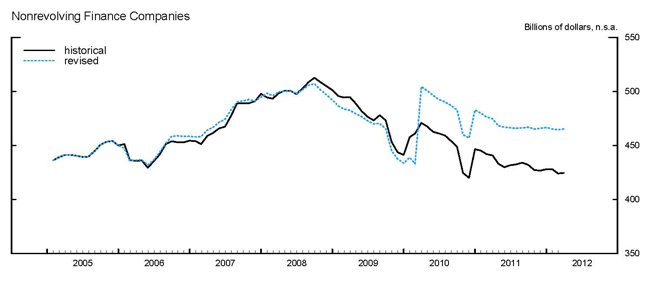
Securitized Pools
Prior to March 2010, revisions to the nonrevolving pools estimates are downward and average approximately 11 1/2 percent (negative $25 billion). These revisions also make up a large part of the revisions to total nonrevolving credit, accounting for approximately half of its downward revisions from January 2006 through February 2010. Loans originated and securitized by depository institutions (specifically savings institutions) and finance companies cause the vast majority of these off-balance-sheet revisions, accounting for roughly 30 and 70 percent, respectively. These estimates of nonrevolving pools decreased from January 2006 through February 2010 because of data adjustments for both consumer motor vehicle and other nonrevolving loans. Upon review of the data and procedures used in this sector, adjustments have been made to ensure that all outstanding pool balances are correctly measured and loans are properly classified by type and holder.
From March 2010 through March 2012, revisions of credit in nonrevolving pools remain downward and increase in magnitude over time, averaging approximately 66 percent (negative $55 billion) of their former values. With respect to total nonrevolving credit, these revisions are largely offset by the corresponding upward revisions of finance companies.
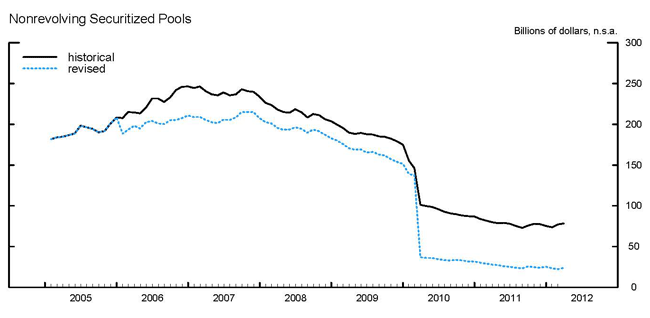
Depository Institutions
The depository institutions sector consists of the former commercial banks and savings institutions sectors. Revisions to nonrevolving credit held by depository institutions are small, averaging less than 0.1 percent ($110 million) of their former values. These changes have a negligible effect on total nonrevolving credit and are caused almost entirely by a methodology change in weighting weekly commercial bank data to generate monthly estimates. In a few instances, alterations to this series are due to minor idiosyncratic data adjustments to better account for panel attrition, panel growth, and loan sales and purchases by panel members.
Credit Unions
Small revisions to credit union estimates are caused by revisions to source data. The new estimates are, on average, less than 0.1 percent ($117 million) below the previous estimates.
Federal Government
Nonrevolving credit held by the federal government is revised downward from January 2006 to March 2012 because of the exclusion of a small amount of student loans for which data are no longer available. These revisions average about 4 1/4 percent (negative $6.4 billion) of the former estimates over the revision period. In March 2012, these loans account for only 1 3/4 percent of the former federal government credit estimate.
Revolving Consumer Credit Sectors
Nonfinancial Business
Revolving nonfinancial business revisions are upward and large. In January 2006, the new estimate is higher by approximately $23 billion and nearly triples the old. The average revision from January 2006 through March 2012 is approximately 275 percent ($24 billion) and accounts for approximately 85 percent of the revision to overall revolving credit. These changes are caused entirely by a change in source data from a private trade publication to the U.S. Census Bureau's Annual Retail Trade Report. The Annual Retail Trade Report allows for consistent measurement of revolving and nonrevolving credit from nonfinancial business using one data source and encompasses a wide range of retail sectors, including furniture, electronics, appliances, food and beverage, gasoline, sporting goods, clothing, general merchandise, and department stores.
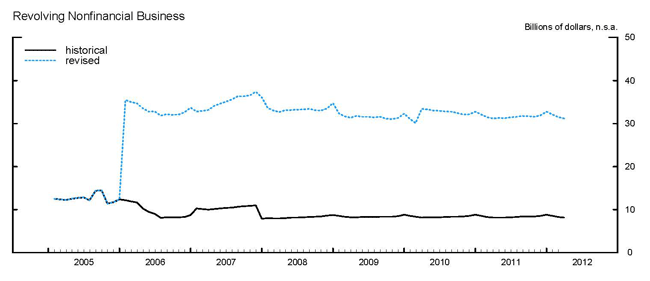
Finance Companies
Prior to March 2010, revisions of finance company revolving credit estimates are downward and average approximately 11 percent (negative $7 billion) of their former values. These adjustments are due to the incorporation of off-balance-sheet transfers that were not previously shown; corresponding increases occur in the revolving securitized pools sector.
In March 2010, the new estimate jumps above the old by roughly 31 percent ($20 billion) because of the inclusion of previously omitted consolidated loans. In terms of overall revolving credit, this upward revision adds to that of the nonfinancial business estimates, though it is partially offset by corresponding downward revisions of the securitized pools sector. The difference between the new and old estimates stays approximately constant at $21 billion through March 2012.
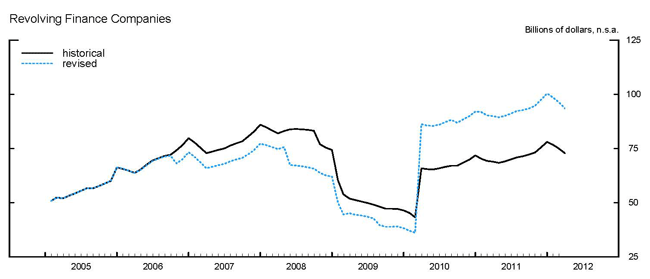
Securitized Pools
Revisions to revolving securitized pools are driven primarily by loans originated and securitized by finance companies and depository institutions and account for up to roughly 15 percent of the revisions to total revolving credit prior to March 2010. For the majority of this period, the revisions are upward, owing to nearly constant upward contributions of loans originated and securitized by finance companies. These changes are due to the inclusion of previously omitted securitized loans which are about 6 3/4 percent of the old estimate of total revolving pools. In March 2010, the newly included loans are consolidated in the finance companies sector and cause no further revisions to securitized pools.
These upward revisions are offset to varying degrees by revisions to loans originated and securitized by depository institutions. Both commercial banks and savings institutions contribute downward revisions before March 2010. Upon review of the securitized consumer loan market and procedures used to estimate securitized pools, estimates have been adjusted to ensure that all outstanding pool balances are correctly measured and loans are properly classified by type and holder.
Revisions to revolving securitized pools are largest beginning in the fourth quarter of 2009 (about $30 billion or 7 1/2 percent of their former values). These revisions reflect the timing of the incorporation of FAS 166 and167-related consolidations at commercial banks. In the previous estimates, consolidations before March 2010 appear in the data as they occur, causing a substantial decline in outstanding credit in securitized pools in the last quarter of 2009. In the new estimates, all declines in off-balance sheet data because of FAS 166 and 167 have been suppressed until March 2010. Note however, that corresponding increases in on-balance-sheet data have also been suppressed until March 2010, so the net effect of such revisions on total revolving credit is essentially zero.
Finally, from March 2010 on, both the new and old estimates fall sharply, with the new estimate falling to approximately 30 percent ($13 billion) below the old estimate. This downward revision in revolving pools is caused by data adjustments for consolidations which were not previously shown, and modestly offsets the upward revisions of total revolving credit from March 2010 through March 2012.
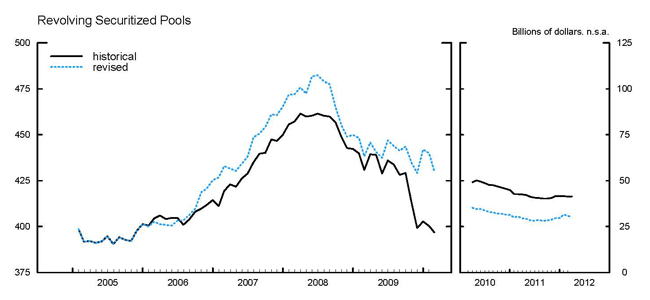
Depository Institutions
The depository institutions sector consists of the former commercial banks and savings institutions sectors. From January 2006 through September 2009, revisions to revolving credit held by depository institutions are small, averaging less than 0.1 percent of their former values (negative $146 million). These changes have a negligible effect on total revolving credit, and are caused almost entirely by a methodology change in weighting weekly commercial banks' data to generate monthly estimates. In a few instances, alterations to this series are due to minor idiosyncratic data adjustments to better account for panel attrition, panel growth, and loan sales and purchases by panel members.
In the last quarter of 2009, the new estimate drops below the old estimate by approximately $25 billion. This drop is caused by the timing of FAS 166 and 167-related consolidations at commercial banks. In the previous estimate, we allowed early (before the first quarter of 2010) consolidations to appear in the data as they occurred. In the new G.19 estimates, we have suppressed all increases in on-balance-sheet data because of FAS 166 and 167 until March 2010. The decrease in commercial banks' contribution to securitized pools is also suppressed until March 2010, so the net effect of these revisions on total revolving credit is essentially zero.
Beginning in March 2010, the revisions to depository institutions' credit shrink back toward zero and have an insignificant effect on total revolving credit.
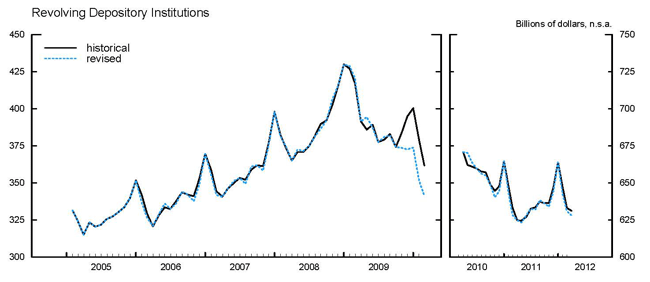
Credit Unions
Minor revisions to credit union estimates are caused by revisions to source data. These revisions average less than 0.1 percent (negative $3 million) and have a negligible effect on total revolving credit.
Footnotes
- See footnotes 2 and 4 of the G. 19 release and http://www.federalreserve.gov/releases/g19/about.htm for more information about series breaks.Return to text
- In 2009, the Financial Accounting Standards Board (FASB) published Financial Accounting Statements FAS 166, Accounting for Transfers of Financial Assets, and FAS 167, Amendments to FASB Interpretation No. 46(R )(Consolidation of Variable Interest Entities), which change the way entities account for securitizations and special purpose entities. Because of these statements, many financial institutions consolidated related special purpose entities onto their balance sheets. Return to text
